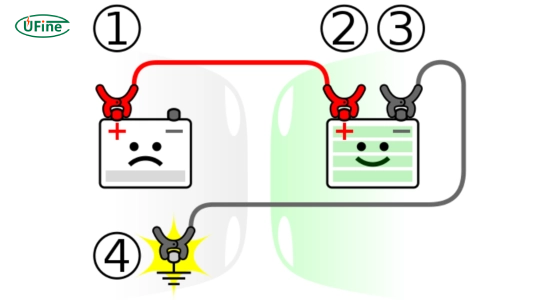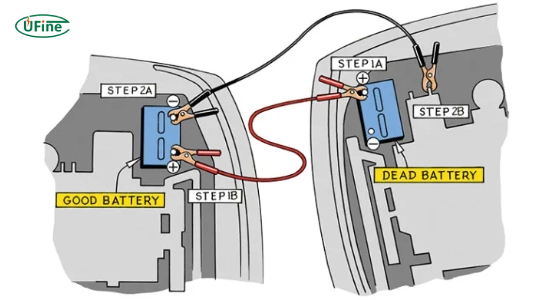Every driver should know how to jump-start a dead battery. Knowing how to do this can save you from being stranded and help you get back on the road quickly. This guide will explore everything you need to know about car batteries, the jump-starting process, and troubleshooting tips if things don’t go as planned.
Part 1. What is a car battery?
A car battery is an essential component of your vehicle’s electrical system. It stores energy in chemical form and provides the electrical power needed to start the engine. Most vehicles use a 12-volt lead-acid battery, which has been the standard for many years. However, with technological advancements, lithium-ion batteries are becoming more popular, especially in electric vehicles (EVs) and hybrid cars.
Lead-acid batteries are known for their reliability and cost-effectiveness, but they can be heavy and may not perform well in extreme temperatures. On the other hand, lithium-ion batteries are lighter, have a higher energy density, and can charge faster. However, they are generally more expensive and require special care.
Understanding these two types of batteries helps you appreciate their roles in your vehicle and why knowing how to jump-start them is essential.
Part 2. Why do batteries die?
Batteries can die for several reasons, including:
- Age: Car batteries typically last between three to five years. As they age, their ability to hold a charge decreases.
- Electrical Drain: Leaving lights on or using electronic accessories while the engine is off can quickly drain the battery.
- Extreme Temperatures: Both hot and cold weather can negatively impact battery performance. Cold weather can slow down chemical reactions inside the battery, making it harder to start your vehicle.
- Corrosion: Corrosion on battery terminals can prevent proper electrical connections, leading to starting issues.
Part 3. Safety precautions before jump-starting
Before you attempt to jump-start a dead battery, it’s crucial to take some safety precautions:
- Wear Protective Gear: Always wear safety glasses and gloves to protect yourself from acid splashes or sparks.
- Remove Jewelry: Metal jewelry can conduct electricity and pose a risk of shock or burns.
- Check for Damage: Inspect both batteries for leaks, cracks, or corrosion before attempting to jump-start.
Part 4. Tools needed
To jump-start a dead battery effectively, you’ll need the following:
- Jumper Cables: Ensure they are in good condition and have no frayed wires.
- Another Vehicle: A car with a fully charged battery or a portable jump starter.
Replacement Lithium Battery for Jump Starter Pack
Part 5. Step-by-step guide to jump-starting a dead battery
Step 1: Position the vehicles
Park the working vehicle close enough to the dead vehicle so that the jumper cables can reach both batteries without the cars touching each other. Turn off both vehicles before proceeding.
Step 2: Identify battery terminals
Locate both batteries’ positive (+) and negative (-) terminals. The positive terminal is usually red and marked with a “+” sign, while the negative terminal is typically black and marked with a “-” sign.
Step 3: Connect the jumper cables
- Connect Red Clamp to Dead Battery: Attach one end of the red (positive) jumper cable to the dead battery’s positive terminal.
- Connect the red clamp to the good battery: Attach the other end of the red cable to the positive terminal of the working battery.
- Connect Black Clamp to Good Battery: Attach one end of the black (negative) cable to the working battery’s negative terminal.
- Connect Black Clamp to Ground on Dead Vehicle: Instead of connecting this end directly to the dead battery’s negative terminal, attach it to an unpainted metal surface on the dead vehicle (like a bolt). This reduces the risk of sparks near the battery.
Part 6. Starting the vehicles
Step 1: Start the working vehicle.
Start the vehicle’s engine with a good battery and let it run for a few minutes. This will allow the dead battery to be charged.
Step 2: Start the dead vehicle.
Attempt to start the vehicle with the dead battery. If it doesn’t start immediately, wait a few moments and try again.
Part 7. After a successful jump start
Once your vehicle starts, let it run for at least 20 minutes to allow the alternator to recharge the battery fully.
Part 8. Disconnecting jumper cables
To safely disconnect jumper cables:
- Remove the black clamp from the grounded metal surface on the previously dead vehicle.
- Remove the black clamp from the negative terminal of the working vehicle.
- Remove the red clamp from the positive terminal of the working vehicle.
- Finally, remove the red clamp from the positive terminal of the previously dead vehicle.
Part 9. How do you jump-start a car without another vehicle?
If you find yourself without another vehicle for a traditional jump start, don’t worry! You can still get your car running using a portable jump starter or even by using specific emergency devices designed for this purpose:
Using a Portable Jump Starter:
- Ensure your portable jump starter is fully charged.
- Connect it just like you would with jumper cables: red clamp to positive (+) terminals and black clamp to negative (-) terminals.
- Follow manufacturer instructions for starting your vehicle.
Using Emergency Battery Packs:
- Some products allow you to connect directly without needing another car.
- Make sure you follow all safety guidelines provided by these devices.
Part 10. What should I do if my car doesn’t start after a jump-start?
If your car doesn’t start after several attempts:
- Check Connections: Ensure all clamps are securely attached and do not touch each other.
- Battery Condition: If your battery is old or damaged, it may need replacement rather than just a jump start.
- Alternator Issues: If your car starts but dies shortly after being jumped, your alternator may not be charging correctly.
Part 11. FAQs
-
What should I do if my car won’t start after jumping?
If your car doesn’t start after several attempts, check that all connections are secure and consider having your battery tested or replaced by a professional. -
Can I jump-start my car if it’s raining?
Yes, but exercise caution, as water can increase risks associated with electrical connections. Ensure everything is dry before proceeding. -
Is it safe to connect jumper cables directly to my dead battery?
While it’s common practice, connecting one end of the negative cable to an unpainted metal surface reduces spark risks near flammable gases emitted by batteries. -
How long should I let my vehicle run after being jumped?
Let your vehicle run for at least 20 minutes after jumping to allow sufficient recharging time. -
Can I use any jumper cables?
It’s best to use heavy-duty jumper cables designed for automotive use; lighter cables may not handle higher currents effectively.
Related Tags:
More Articles

Aluminum Air Battery Design: Materials, Assembly & Efficiency Tips
An aluminum air battery uses aluminum and air to generate power. Learn its materials, assembly steps, and tips to boost energy output and efficiency.
7 Advantages of a Heated Lithium Battery in Cold Climates
Looking to power batteries in freezing temps? Heated lithium batteries excel in cold climates. Here are 7 key benefits and how they work.
How to Choose the Best Floor Scrubber Battery for Commercial Cleaning?
Selecting the ideal floor scrubber battery ensures a long runtime, rapid charging, and minimal maintenance for efficient commercial cleaning operations.
Battery for Blower vs Battery for Leaf Vacuum: Which One Should You Choose?
Battery for blower vs leaf vacuum—learn the key differences in power, fit, and runtime to choose the right battery for your outdoor tool needs.
How to Choose the Right Battery for Blower?
Choosing the right blower battery? Consider voltage, capacity, chemistry & usage. This guide helps match the best battery for peak performance.






